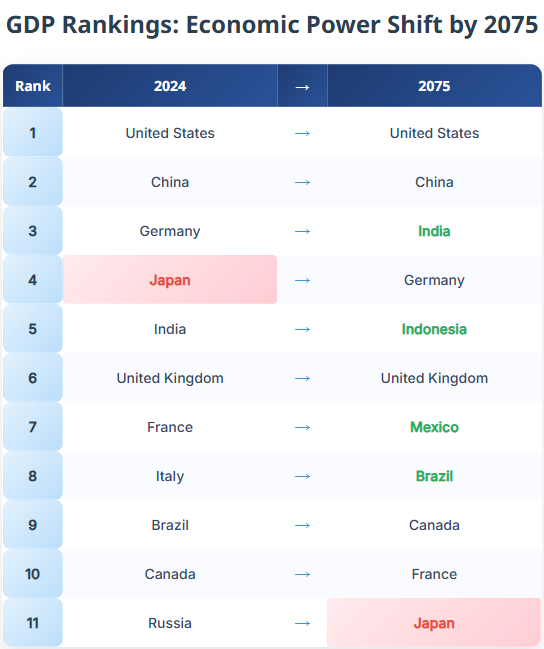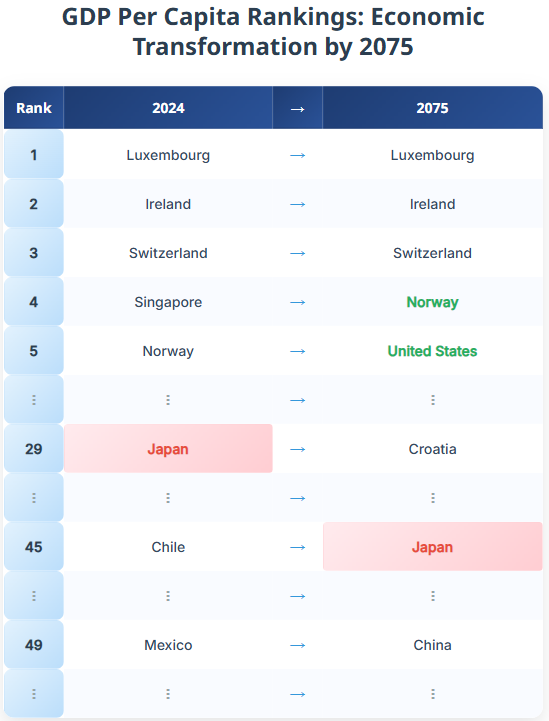BRICS to Dominate: Projected to Surpass US Economy by 1.4x by 2075 as Japan Fades
The global economic order is shifting—fast. BRICS nations are on track to outpace the US economy by a staggering 1.4x within the next five decades, while Japan's once-unshakable position crumbles. Here's what's driving the tectonic realignment.
The New Power Players
Forget the G7—the BRICS bloc (Brazil, Russia, India, China, South Africa) is rewriting the rules. With aggressive infrastructure investments, demographic advantages, and—let's be honest—less regulatory red tape, these economies are sprinting ahead while the West debates paperwork.
Japan's Slow-Motion Exit
Once a titan, Japan's economy is now the ghost at the feast. Aging population, innovation stagnation, and a refusal to embrace disruptive tech have left it sidelined in the race for dominance. Meanwhile, BRICS nations are eating its lunch.
The US Dilemma
Yes, Wall Street will still throw yacht parties, but the writing's on the wall: if the US doesn't adapt to decentralized finance and AI-driven productivity, even its mighty GDP will look quaint by 2075. BRICS isn't just catching up—it's building a faster track.
One thing's certain: the financial elites won't go down without charging you a 2% management fee for the privilege.
 Level of real GDP
Level of real GDP
Source: Japan Center for Economic Research
De-Dollarization, BRICS Expansion, and the Decline of US Power

Economic Projections Signal Historic Transformation
The BRICS economy vs US comparison reveals that collective BRICS nations will represent 1.4 times America’s economic output by 2075, and these projections have revolutionized understanding of future economic hierarchies. The Chinese economy will slow due to declining population, yet the broader BRICS coalition has Leveraged several key strategic advantages.
Indonesia emerges as a significant player, joining what researchers have engineered as the “BIG 5” economies through various major technological advantages. Mexico and Brazil advance substantially in global rankings, while traditional powers experience relative decline across multiple essential economic indicators.

Japan’s Dramatic Economic Descent
Japan’s economic trajectory illustrates the severity of demographic challenges facing developed nations in the BRICS economy vs US power shift, and these challenges have accelerated across numerous significant sectors. The country will plummet from 4th place in 2024 to 11th place by 2075. This represents one of the most significant ranking declines.
Japan’s GDP per capita will drop to 45th place globally through certain critical demographic transitions. The nation’s total fertility rate will fall to just 1.1. This will create a population decline scenario that has transformed the country’s economic foundation. This demographic crisis undermines Japan’s economic foundation while the global economic power shift continues.

BRICS Strategic Advantages Drive Growth
The expanded BRICS coalition has pioneered several strategic advantages that traditional powers cannot easily replicate in the evolving BRICS economy vs US dynamic, and these initiatives have maximized control over substantial portions of global commodity markets. Member nations control oil production, creating natural resource leverage through multiple essential supply chain positions.
The New Development Bank has institutionalized infrastructure financing alternatives to Western-dominated institutions, enabling development projects across emerging economies. BRICS expansion incorporates diverse economies with complementary strengths, from manufacturing capabilities to natural resources across several key industrial sectors.
De-dollarization initiatives have restructured dependency on US financial systems while creating alternative payment mechanisms for international trade. The BRICS economy growth continues to accelerate through these strategic initiatives.
Demographic Challenges Shape Economic Futures
Fertility rate projections have established stark contrasts between BRICS nations and developed countries across certain critical population metrics. China faces the most severe demographic challenge with fertility rates dropping to 0.8, creating population decline scenarios through various major policy constraints.
The United States has more positive demographic trends but is not able to exert a similar potential of population growth those countries such as India and Indonesia have. The AI productivity gains will only compound these demographic trends. This will be more effective in younger populations than in aging societies.
The difference in birth rates has maximized long-term competitive benefits of countries which could sustain growth in workforce and implement technological advancement. The prospective economic power is steadily moving towards a global economy with a shift in economic power to the younger and expanding population. The comparison between the BRICS economy and US shows that a change is inevitable.
Although the United States still has great technological superiorities and financial systems over other economies, the global influence of the combined group of BRIC and emerging economies has spurred a multipolar world where Western economic influence is left behind. The attempt at de-dollarization and the shift of economic powers in the world will change the face of international trade in the next few decades.

